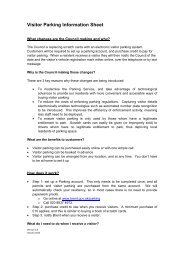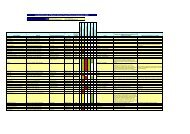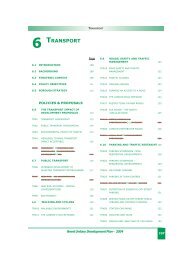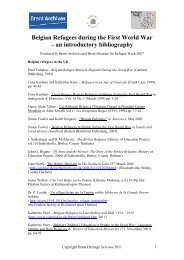Planning for Sport and Active Recreation Facilities ... - Brent Council
Planning for Sport and Active Recreation Facilities ... - Brent Council
Planning for Sport and Active Recreation Facilities ... - Brent Council
Create successful ePaper yourself
Turn your PDF publications into a flip-book with our unique Google optimized e-Paper software.
Map 31: Travel time map – sports halls<br />
Map 32: Personal share – sports halls<br />
57<br />
Symbol<br />
Personal Share of <strong>Sport</strong>s Halls<br />
Map 32 indicates areas within the borough which have<br />
high personal share (red) <strong>and</strong> low personal share (green).<br />
The map shows that residents who live in the South<br />
of the Borough have less personal share of sports halls<br />
compared to wards such as Queensbury <strong>and</strong> Fryent.<br />
Compared to London, <strong>Brent</strong> residents have a personal<br />
share of 0.76m² compared to London’s average of<br />
0.89m² <strong>and</strong> the national average of 1.43 m² per resident.<br />
Travel Time<br />
(minutes walking)<br />
0.42 - 4.632<br />
4.633 - 8.844<br />
8.845 - 13.056<br />
13.057 - 17.268<br />
17.269 - 21.48<br />
<strong>Facilities</strong> <strong>Planning</strong> Model<br />
<strong>Sport</strong>s Halls Run 1- key findings -<br />
current population <strong>and</strong> provision<br />
The findings of the <strong>Facilities</strong> <strong>Planning</strong><br />
Model (FPM) run <strong>for</strong> 2007 identifies<br />
that the capacity of <strong>Brent</strong>’s sports halls<br />
is above the London average. In fact, it<br />
is the second highest level of sports hall<br />
capacity across the study area (the seven<br />
neighbouring boroughs). However,<br />
because of issues of accessibility, dem<strong>and</strong><br />
outstrips capacity considerably across the study area as a<br />
whole.<br />
The FPM only includes sports halls with some public<br />
accessibility <strong>and</strong> over 459 m2 in size (3 badminton<br />
courts), as it is stated that sports halls need to<br />
be this size to make a significant impact on<br />
the community. However, smaller halls, as<br />
identified earlier, do play a part in meeting<br />
some local dem<strong>and</strong>. This means that,<br />
in total <strong>for</strong> this study, there were 48<br />
badminton courts located on ten sites.<br />
Currently within <strong>Brent</strong>, unmet dem<strong>and</strong> st<strong>and</strong>s at 28.6%<br />
of the population - this equates to approximately 18<br />
publicly accessible badminton courts. The South East of<br />
the borough has the highest shortage at present <strong>and</strong><br />
17% of satisfied dem<strong>and</strong> is imported from Westminster,<br />
with 15% of dem<strong>and</strong> imported from Kensington &<br />
Chelsea. Some residents living in Welsh Harp <strong>and</strong><br />
Dollis Hill wards live outside a 1 mile catchment of a<br />
publicly accessible sports hall. Graph 7 illustrates the<br />
boroughs population that has access to sports halls, <strong>and</strong><br />
it shows that 14% of the borough do not have access<br />
to any publicly accessible sport halls. Compared to the<br />
neighbouring boroughs, this is only better than Barnet<br />
<strong>and</strong> Hammersmith <strong>and</strong> Fulham’s score.



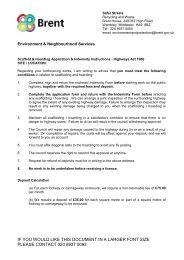



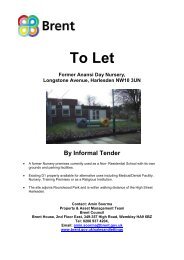
![0702012-khat[1] - Brent Council](https://img.yumpu.com/11457346/1/184x260/0702012-khat1-brent-council.jpg?quality=85)
